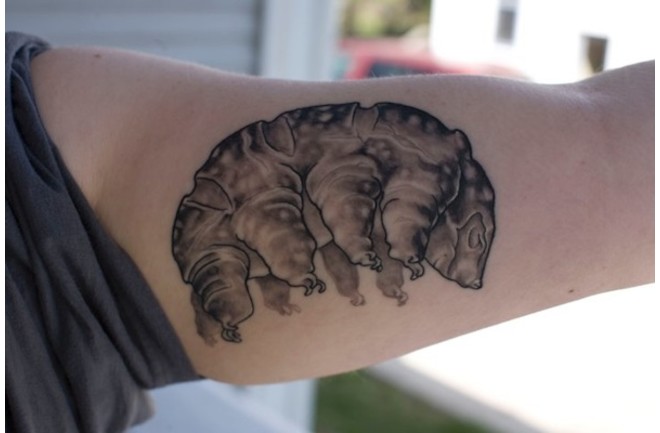
Spencer Debenport, a plant pathologist at Ohio State University, sports a tattoo of a tardigrade, a microscopic animal known as the water bear. “I have always loved microscopic critters, and there is none other as intriguing as the tardigrade,” he writes. “The fact that they are so hardy, yet still that odd mixture of ugly/cute drew me to them and the more I read up on them, the more I wanted one permanently on me. I am also a mycologist, so whenever I look at lichens I get to see loads of these little guys roaming around.”
In Science Ink, I included another tattoo of a tardigrade, and describe it this way:
Tardigrades make the world their hiding place. They live invisibly in the ground, in the muck of ponds and deep-sea sediments, in dunes, in moss, in stone walls, on the tops of mountains, and deep inside glaciers. They go unnoticed thanks to their miniature dimensions: the biggest tardigrades don’t get bigger than a poppy seed. When the naturalist Johann August Ephraim Goeze discovered tardigrades in 1773, he dubbed them kleiner Wasserbear, meaning little water bear. Their stocky bodies and stumpy legs do give them an ursine cast, but there aren’t many bears that have eight legs, or daggers in their mouths that pierce smaller animals or algae cells.
There are also aren’t many bears that could be taken aboard a spacecraft, left out in the vacuum of space for ten days, and still be alive when they returned to Earth. But tardigrades have made this journey. Here on Earth, they can survive without water by going into a state of suspended animation. Even after nine years a splash of water can revive them. No one is quite sure how tardigrades manage all this. Some experiments hint that they can turn their bodies into a liquid that’s as hard as a solid. Scientists call it biological glass.
You can see the rest of the Science Tattoo Emporium hereor in my book,Science Ink: Tattoos of the Science Obsessed.
[Tattoo by Shawn Hebrank at Identity Tattoo in Minneapolis, MN. Photo: Dylan Nelson (dylanjamesnelson.com)]
Originally published November 7, 2011. Copyright 2011 Carl Zimmer.